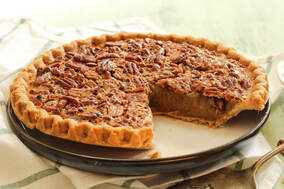…from the Perspectives Kitchen How you doin’? A lot of people think pie is just for holidays. I’m here to tell you pie is for every day. I consider pies—the way grandmother used to bake them—the quintessential American dessert for any time of year, but especially for the holidays. A slice of pie is so versatile it can be served with whipped cream, ice cream, creme anglaise or just naked, right out of the pie pan. I think of pie as a food with a lid—a lid you can eat, with edible sides and base, too. When you think about it, the pie is a masterpiece of gastronomical engineering. Perhaps it should come as no surprise then, that 65% of Americans population eat a pie (sweet or savory) at least once a month. With fillings and pastry cases to suit all dietary needs, it’s a dish that can turn up on anyone’s plate and when you consider the history of the pie, it’s been on a long and fascinating historic journey. The Ancient Egyptians were the first to invent a dish close to what we know today as a pie. They had a honey filling covered in a crusty cake made from oats, wheat, rye or barley. A recipe for chicken pie was discovered on a tablet carved prior to 2000 BC. Later on, closer to the 5th Century BC, the Ancient Greeks were believed to invent pie pastry as it is mentioned in the plays of the writer Aristophanes and it was possible to work as a pastry chef in this era, a separate trade to a baker. The Romans took the concept of pies even further. They would make a pastry of flour, oil and water to cover up meat, but this was intended to preserve the juices and flavors of the filling and was not intended to be eaten. A Roman cookbook from the 1st Century, called Apicius, mentions recipes that include pie cases. There is even one that we would recognize as a cheesecake, using pastry for a base, which has the interesting name--placenta. With the Romans came roads, and thus their pies (and their recipes) eventually found their way around all parts of Europe. The Oxford English Dictionary first records pastry as a word in use by the mid-14th Century and Medieval Latin included the word ‘pie’, meaning ‘meat or fish enclosed in pastry’ from around 1300. In Britain, the first pyes had mainly meat fillings and, just as in Rome, the pastry cases were not necessarily for eating. They were to help food last longer on sea voyages, and also save space - having a hold stacked with pies was a far more sensible use of precious square feet than bringing a cook and dozens of livestock along for the journey. By medieval times, cooks tried to outdo each other as pies became the centerpiece of exclusive banquets. Anything would be baked into them which would impress as the pastry lid was removed to reveal its unique fillings. Sometimes this would even include live actors reciting poetry (safely hidden inside after the baking process), or even a band of musicians… that must have been one rather larger pie! Queen Elizabeth I’s reign will be remembered for such things as her defeat of the Spanish Armada and an age of literature which included William Shakespeare and Christopher Marlowe. Cherry pie was, allegedly, first served up to old Lizzy. Pies were even becoming dramatic devices by this time. The William Shakespeare killed off two male characters in Titus Andronicus by having them baked into a pie as revenge for them attacking the title character's daughter. Titus then served the pie to his victims’ mother. World exploration gathered pace and as people from England settled in America, so too did their pie recipes, evolving away from further British influences. Apple pie became a symbol of American life… the heavy American association dates back to the World War II when soldiers were asked why they were off to battle, they would often reply: “For mom and apple pie.” Even today, pies continue to evolve as new cultures and trends affect the fillings we put inside them. Cases made from puff pastry, filo and short crusts are now popular and are just as important a part of the dish as what’s inside, no longer being treated as flour-based crockery. Butternut squash is now just as good a pie filling as a bit of Stilton or steak and ale. With pastry now suitable for vegetarian and vegan diets, as well as the sweet crusts which enrobe the richest of dessert fillings, it seems the answer to ‘who ate all the pies’ is clearer than ever—it’s all of us. As you may already know, pecans are native to North America, which is why it makes sense that the pecan pie was created here as well. There are some who believe that the pecan pie originated in New Orleans after it was settled by the French, although that doesn’t seem to be the most accepted accreditation. Early pecan recipes first appeared in Texas cookbooks in the 1870s and 1880s. The first recipe that resembled a pecan pie was published in St. Louis in 1898. My pecan pie recipe has the hint of Old Kentucky Bourbon. You can use more or less of it as you desire. It has great upper notes of caramel and butter along with the toasty pecans and hints of brown sugar and vanilla. Along with the crust recipe below, I consider this my best of the best nut pie recipes and worthy of a blue ribbon! Prep time: 15 minutes (plus crust time) Bake time: 1 hour Yield: 5 to 8 servings / 1 (9 inch) pie Ingredients 1 cup white corn syrup (Karo) 1 cup dark brown sugar, firmly packed 1/4 teaspoon salt 1/2 cup unsalted butter, melted 2 teaspoons pure vanilla extract 2 tablespoons bourbon (or more to your taste) 3 large eggs, plus 1 egg yolk (yolk is for the egg wash) 1 tablespoon warm water 1-1/2 cups whole pecans 1 recipe pie shell for two (2) 9-inch crust pies (see recipe below) Directions
ChefSecrets: To make it a Chocolate Pecan Pie, add 1/4 cup of chocolate chips to the bottom of the crust before adding the pie filling. Sweet & Flaky Pie Crust Prep time: 15 minutes Chill time: 30 minutes minimum Yield: 2 single or 1 double (9-inch) pie crust Ingredients 3/4 cup cold unsalted butter 1/4 cup vegetable shortening (Crisco) or lard (I prefer lard) 1/4 to 1/2 cup ice water 3 cups all-purpose flour, plus more for rolling 1/4 cup granulated sugar 1/2 teaspoon sea salt Directions
ChefSecret: Lard is the secret to a light, flaky crust. Quip of the Day: “Pecan pie is like duct tape; it fixes everything that ails you.” ------------------------------------------- Do you have a question or comment? Send your thoughts to [email protected]. All recipes and cooking tips are posted on our website https://www.perspectives-la.com/covid-19-survival-guide. ------------------------------------------- To you and everyone dear to you, be strong, positive, stay well, stay safe and be kind. Take a breath and count your blessings, and if you have a little extra to share with others, please consider donating to Feeding America and/or American Red Cross. #ThanksgivingRecipes #Thanksgiving #Baking #PecanPie #BourbonPecanPie #Bourbon #Holidays2023 #BeThankful #QuarantineKitchen #Covid19 #RedCross #FeedingAmerica #PerspectivesTheConsultingGroup ©PERSPECTIVES/The Consulting Group, LLC, 2023
0 Comments
Your comment will be posted after it is approved.
Leave a Reply. |
For over 4 decades collaboration and vision have been the cornerstones of our approach to developing innovative solutions. We fuel innovation, uncover opportunities, discover trends and embrace sustainability, turning imaginative ideas into profitable realities. Categories
All
Archives
July 2024
|
www.perspectives-la.com
Copyright © 2021 Perspectives/The Consulting Group, LLC | Henderson, NV 89052 | 310-477-8877
Copyright © 2021 Perspectives/The Consulting Group, LLC | Henderson, NV 89052 | 310-477-8877


 RSS Feed
RSS Feed